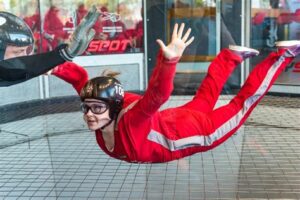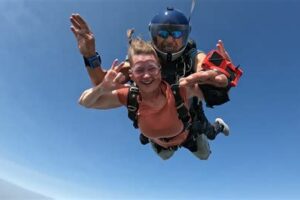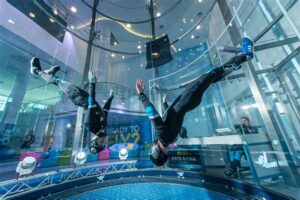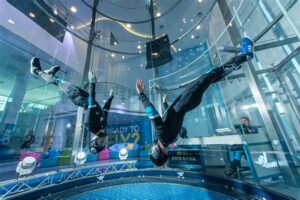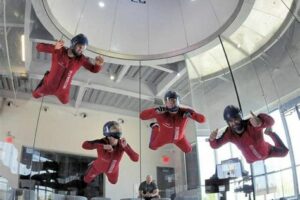Table of Contents
Looking to build an indoor skydiving facility? Learn about the cost involved in constructing an indoor skydiving center, including factors like equipment, construction, permits, and staff training. Get insights into the financial investment required to bring the thrill of skydiving indoors.
When it comes to the thrilling experience of indoor skydiving, many people wonder about the cost to build such a facility. From the state-of-the-art wind tunnels to the safety measures in place, constructing an indoor skydiving center requires careful planning and significant financial investment. However, the exhilaration of defying gravity and feeling the rush of wind beneath your wings make it all worth it. So, let’s dive into the world of indoor skydiving and explore the fascinating aspects of its construction costs.
Introduction
Indoor skydiving, also known as vertical wind tunnels, has become an increasingly popular activity for thrill-seekers and aviation enthusiasts. It offers the exhilaration of skydiving without the need for an actual plane or jumping out of one. If you are considering building an indoor skydiving facility, it is essential to understand the costs involved. From construction to equipment, this article will provide a comprehensive overview of the expenses associated with building an indoor skydiving facility.
Location and Building
The first step in building an indoor skydiving facility is finding the right location. The size and layout of the building will depend on factors such as the number of participants you plan to accommodate and the type of experience you want to offer. The cost of purchasing or leasing the building can vary greatly depending on its size, condition, and location.
Construction and Renovation
Once you have secured a suitable building, the next step is constructing or renovating the space to accommodate the vertical wind tunnel. This process involves creating a large airflow chamber with specialized materials and engineering to ensure safety and functionality. The cost of construction and renovation can vary significantly depending on the complexity of the design and the expertise required.
Vertical Wind Tunnel
The centerpiece of any indoor skydiving facility is the vertical wind tunnel. This device generates a powerful updraft of air that simulates the feeling of freefall. The cost of a vertical wind tunnel can range from hundreds of thousands to millions of dollars, depending on the size, technology, and customization options. It is essential to choose a reputable supplier with experience in building reliable and safe wind tunnels.
Safety Equipment
Ensuring the safety of participants is of utmost importance. Building an indoor skydiving facility requires investing in various safety equipment such as helmets, suits, goggles, and harnesses. The cost of safety equipment can vary based on the quality, quantity, and brand. It is crucial to prioritize safety and invest in high-quality gear to provide participants with a secure and enjoyable experience.
Training and Staff
To operate an indoor skydiving facility, you will need a well-trained and experienced staff. This includes instructors, technicians, and support personnel. The cost of training staff will depend on the qualifications required and the duration of the training program. It is essential to invest in comprehensive training to ensure the highest level of safety and customer satisfaction.
Marketing and Advertising
Once your indoor skydiving facility is built and ready to operate, you will need to invest in marketing and advertising to attract customers. The cost of marketing can vary depending on the strategies and channels used. It is essential to develop a comprehensive marketing plan that includes online and offline efforts to reach your target audience effectively.
Operational Costs
Running an indoor skydiving facility involves ongoing operational costs such as electricity, maintenance, insurance, and staff salaries. These expenses can vary depending on the size of the facility, the number of daily operations, and the local market conditions. It is crucial to factor in these costs when determining pricing and developing a sustainable business model.
Licensing and Permits
Before opening an indoor skydiving facility, it is necessary to obtain the required licenses and permits from relevant regulatory authorities. The cost of licensing and permits can vary depending on the location and local regulations. It is crucial to consult with legal experts or professionals familiar with the industry to ensure compliance and avoid any unnecessary fines or delays.
Return on Investment
Building an indoor skydiving facility is a significant investment, both financially and strategically. The return on investment can vary depending on several factors such as location, market demand, pricing, and customer satisfaction. It is essential to conduct a thorough feasibility study and financial analysis to determine the potential revenue streams and estimate the time it will take to recoup the initial investment.
Conclusion
Building an indoor skydiving facility requires careful planning, significant investment, and attention to detail. From finding the right location to investing in safety equipment and marketing efforts, the costs involved can be substantial. However, with proper execution and a solid business plan, an indoor skydiving facility can provide an exhilarating experience for customers while offering a lucrative business opportunity for entrepreneurs in the aviation and adventure industry.
Indoor Skydiving Cost To Build
Building an indoor skydiving facility involves significant construction expenses, including site preparation, foundation work, and the installation of a vertical wind tunnel. These costs can vary depending on the size and complexity of the project, but a rough estimate ranges from $5 million to $10 million.
Construction Expenses
The construction expenses for an indoor skydiving facility are substantial. They encompass various aspects, starting with site preparation. This includes clearing the land, leveling it, and ensuring it is suitable for building. Foundation work is another crucial expense, as it forms the base on which the entire structure will be erected.
However, the most significant cost component in building an indoor skydiving facility is the wind tunnel installation. The wind tunnel is the heart of the facility and is responsible for creating the vertical airflow that allows participants to experience the sensation of skydiving. The price of a wind tunnel can vary greatly depending on its size, power, and design. A high-quality, state-of-the-art wind tunnel can cost anywhere from $2 million to $6 million.
Building Design and Architecture
Creating an engaging and attractive environment for customers is crucial in the indoor skydiving industry. Investing in architectural design, lobby decor, and viewing areas not only adds to the overall cost but also enhances the customer experience. The design and architecture should be visually appealing and functional, ensuring a smooth flow of participants through the facility.
Depending on the level of customization and desired ambiance, these expenses can range from $500,000 to $1 million. It is important to consider factors such as the layout, lighting, and aesthetics to create a space that captivates customers and leaves a lasting impression.
HVAC System
A well-designed and efficient HVAC (Heating, Ventilation, and Air Conditioning) system is essential in maintaining the optimal temperature and airflow within the facility. Given the extreme conditions inside the wind tunnel, specialized HVAC systems are required. These systems ensure that participants are comfortable during their skydiving experience.
The cost of installing an appropriate HVAC system can range from $300,000 to $500,000. It is crucial to invest in a reliable and efficient system that can handle the demands of maintaining the desired temperature and airflow levels within the facility.
Safety and Training Equipment
Providing top-notch safety and training equipment is paramount in an indoor skydiving facility. Flight suits, helmets, goggles, and safety padding are essential to ensure the safety and well-being of participants. The cost of these items will depend on the number of participants the facility can accommodate.
On average, the cost of safety and training equipment ranges from $50,000 to $100,000. It is imperative to invest in high-quality equipment that meets industry standards and can withstand the rigors of frequent use.
Facility Amenities
To create a memorable experience for customers, it is important to incorporate amenities such as lockers, showers, restrooms, and a comfortable waiting area. These amenities enhance the overall customer experience and provide convenience during their visit to the facility.
The cost of installing these amenities can range from $100,000 to $200,000, depending on the size and quality desired. It is crucial to allocate a budget for these amenities to ensure that customers have access to the necessary facilities and feel comfortable throughout their visit.
Marketing and Advertising
Promoting an indoor skydiving facility is essential to attract customers. Allocating a budget for marketing campaigns, website development, and online advertising should be considered. Effective marketing strategies can help generate awareness and drive customer interest in the facility.
Depending on the scale of promotion, a yearly marketing budget can range from $100,000 to $500,000. This investment is crucial to reach the target audience and create a strong brand presence in the market.
Ongoing Operational Costs
Beyond the initial construction expenses, ongoing operational costs must be factored in. These include utilities, maintenance, insurance, and employee wages. Monthly operational costs can total anywhere from $50,000 to $100,000, depending on the facility’s size and location.
Utilities such as electricity and water are necessary to ensure the smooth functioning of the facility. Regular maintenance is vital to keep the wind tunnel and other equipment in optimal condition. Insurance coverage protects against unforeseen events, providing peace of mind for both the facility owners and participants. Lastly, employee wages contribute to the day-to-day operations and the overall customer experience.
In conclusion, building an indoor skydiving facility requires significant investment. Construction expenses, wind tunnel installation, building design and architecture, HVAC systems, safety and training equipment, facility amenities, marketing and advertising, and ongoing operational costs all contribute to the overall cost of the project. By carefully considering these aspects and allocating the appropriate budget, a successful and thriving indoor skydiving facility can be built.
Indoor skydiving is an exhilarating and unique experience that allows individuals to feel the thrill of freefalling in a controlled environment. For those who are fascinated by this adventure sport, the idea of building an indoor skydiving facility may seem like a dream come true. However, it is essential to consider the costs involved in constructing such a facility.
1. Construction Expenses: Building an indoor skydiving facility requires a significant investment in terms of construction costs. This includes the cost of acquiring land or renting a suitable location, obtaining necessary permits and licenses, and hiring construction professionals. The expenses can vary depending on the size and complexity of the facility, but it is generally a substantial investment.
2. Wind Tunnel: The centerpiece of any indoor skydiving facility is the wind tunnel. This vertical column of air creates the sensation of freefall and is crucial for providing a safe and enjoyable experience for participants. The cost of purchasing or constructing a wind tunnel can range from hundreds of thousands to millions of dollars, depending on the size and specifications required.
3. Facility Infrastructure: In addition to the wind tunnel, an indoor skydiving facility needs various infrastructure components to ensure smooth operations. This includes ventilation systems, air conditioning, safety equipment, viewing areas, reception and administrative spaces, and amenities for customers. These infrastructure costs can add up significantly and should be factored into the overall budget.
4. Staffing and Training: Running an indoor skydiving facility necessitates having a skilled and trained team. From instructors to maintenance personnel, staffing costs should be considered. Additionally, staff training and certifications should be accounted for to ensure the safety and quality of the experience provided to customers.
5. Marketing and Promotion: Once the indoor skydiving facility is built, it is crucial to attract customers and generate awareness. Marketing and promotional activities, including online advertising, print media, social media campaigns, and partnerships with local businesses, are essential to drive footfall and revenue. Allocating a budget for marketing initiatives is vital to ensure the success of the facility.
Overall, building an indoor skydiving facility requires a substantial financial commitment. It is crucial to conduct thorough research and analysis to determine the feasibility and profitability of such an endeavor. While the costs may seem daunting, a well-planned and executed facility can provide an unforgettable experience for thrill-seekers and enthusiasts alike.
Thank you for taking the time to visit our blog and learn more about the cost of building an indoor skydiving facility. We hope that the information we have provided has been helpful in giving you a better understanding of what is involved in this exciting venture. As you may already know, indoor skydiving is a rapidly growing industry that offers a unique and thrilling experience for people of all ages and skill levels. Whether you are a seasoned skydiver looking to perfect your skills or someone who simply wants to experience the thrill of freefall without the need for an airplane, building an indoor skydiving facility can be a highly rewarding endeavor.
When it comes to the cost of building an indoor skydiving facility, there are several factors to consider. The most significant expense is typically the construction of the wind tunnel itself. This includes the design and engineering, as well as the materials and labor required to build a structure that can withstand the powerful winds necessary for indoor skydiving. Additionally, there will be costs associated with the ventilation system, which is essential for maintaining the proper airflow within the tunnel. Other expenses may include the purchase of flight suits and helmets for customers, as well as any necessary safety equipment.
While the cost of building an indoor skydiving facility can vary depending on factors such as location and size, it is important to approach this project with a realistic budget in mind. It is recommended to work closely with experienced professionals who specialize in the design and construction of wind tunnels to ensure that your facility meets all safety standards and provides a top-notch experience for your customers. By carefully considering all aspects of the project and working with reputable suppliers, you can create an indoor skydiving facility that not only meets your budgetary requirements but also exceeds the expectations of your future visitors.
In conclusion, building an indoor skydiving facility can be a significant investment, but one that can offer tremendous rewards both financially and personally. The thrill and excitement of indoor skydiving continue to attract a growing number of enthusiasts, making it an attractive business opportunity. By understanding the various costs involved and working with professionals in the field, you can embark on this venture with confidence. We hope that our blog has provided you with valuable insights into the cost of building an indoor skydiving facility and that you feel inspired to pursue this exhilarating endeavor. Good luck!
Video Indoor Skydiving Cost To Build
Here are some common questions that people also ask about the cost to build an indoor skydiving facility:
-
How much does it cost to build an indoor skydiving facility?
The cost to build an indoor skydiving facility can vary depending on several factors such as the size of the facility, location, and the level of customization. On average, the cost can range from $5 million to $10 million.
-
What are the main expenses involved in building an indoor skydiving facility?
The main expenses involved in building an indoor skydiving facility include construction costs, equipment costs (such as wind tunnels and safety systems), architectural and engineering fees, permits and licenses, interior design and decorations, and marketing expenses.
-
Is it profitable to invest in an indoor skydiving facility?
Investing in an indoor skydiving facility can be profitable if managed effectively. The profitability depends on various factors including the number of customers, pricing strategy, operational costs, and marketing efforts. Conducting a thorough market analysis and creating a solid business plan can help determine the potential profitability of such an investment.
-
Are there any ongoing costs associated with operating an indoor skydiving facility?
Yes, operating an indoor skydiving facility has ongoing costs. These can include staffing costs (instructors, maintenance personnel, customer service), utility bills, insurance premiums, equipment maintenance and repair, marketing and advertising expenses, and general overhead expenses.
-
Are there any specific regulations or permits required to build an indoor skydiving facility?
Yes, building an indoor skydiving facility involves obtaining various permits and complying with regulations specific to the location. These can include building permits, zoning approvals, fire safety certifications, health and safety regulations, and environmental permits. It is important to consult with local authorities and experts in the field to ensure compliance with all necessary requirements.
Remember, the cost to build an indoor skydiving facility can vary significantly based on individual circumstances. It is advisable to consult with professionals in the industry to get accurate and tailored cost estimates for your specific project.

